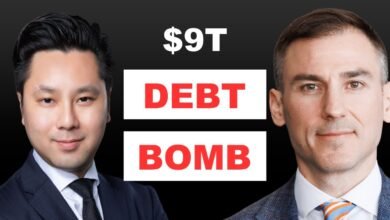Jim Grant’s Golden Truth – Part I (Uncut) 02-20-2025
Jim Grant’s Golden Truth – Part I
I truly believe in gold is a monetary asset not as a Keepsake not necessarily as a specula play thing although to to be sure it does serve that function as well but I believe in it as a as as money that will if not supplant then at least will keep company with present day paper currency greetings and Welcome to our show uh today we’re with Jim Grant the editor author publisher of the aonomus grants interest rate Observer my name is Trey Wright from Bristol Gold group um how are things doing in the Big Apple
today Jim it is uh sunny and cold uh unlike the gold Mark which is sunny and hot and unlike uh the friction of the Trump presidency which is very hot yes it is yeah almost think he was wants to start a little bit of trouble yeah can you believe that well you’ve been writing 12-page reports 24 times a year for 40 years 42 my uh 42 42 yeah there we go on 42 I like to yeah so that’s something like 12,000 pages and I think over time uh some of us have been exposed to Grants for so long that we fall into the
Trap of perhaps taking it for granted taking grants for granted if lack of a better phrase and I’m here today at least in part to encourage people not to do so and uh we wanted to explore a little bit what Grant still has to offer and what continues to offer so in that regard as you look back over the 42 years how would you summarize what you believe Grant’s Mission has been and how do you think you’ve done what’s the value added of Jim Grant oh my goodness well we uh are in business to imagine
the next thing and um to that end we try to uh apply the tool tools of financial analysis and uh a little bit of history and you know you there are half a do dozen of us in this room so we can hardly keep up with h these giant factories of thought and of Securities analysis and securities fogging that U constitute the uh uh the working groups of Wall Street so we have to we have to pick our spots and those spots typically have something to do with uh with outter favor Securities they have something to favor
something to do with h with wrinkles in history that might seem applicable at the present moment um and uh yeah so that’s that’s what we’re about to MH so my children uh get a kick out of watching me write chat because they rarely see it happen and I was watching an interview you did earlier this week and there was a one of the last operating rolodexes in the world background of your where is it your desk and when when when I see those things it does remind us that you know we’re getting we’re getting a little
older and my question is H how have you adjusted uh to contemporary markets and and how do contemporary investors you know best apply the prism of your work uh you know to things like Bitcoin well I I was in uh the odan restaurant I’m not sure if you knows on West Broadway other day and I was there first in the early early 80s and I told the Mater D the the less you change the more I like it and that’s okay for a restaurant but is not so good for the Adaptive world of Finance uh everything changed all the
time I think um I am a little bit susceptible to Nostalgia I must admit to being 78 and a half I suppose that comes with the territory also I write about history and uh do some biography in my spare spare time so um uh Nostalgia must be the least repaying emotion one can bring to the office the morning uh so uh so the trick is to uh is to recognize the truism uh that markets change Always adaptive right they always looking for Market seemingly always want to uh uh want to invent the thing that you’ve never heard of just to confound
people of a certain age and the trick is to recall um that that is the way of Marcus and yet to recognize that the human beings um adamantly refuse to change we insist as a class of animal uh to buy high and sell low that seems to be in DNA and we are uh highly susceptible to the thing that worked last and to the shiniest thing and we are most impatient with people shall we again we say at a certain age saying yes but don’t you recall that or haven’t you spent enough time in the public library to realize that you were sounding just
like John Law yeah so my job is to convey uh that observation that uh many people do just sound like John Law especially people in the White House these days they they talk about U monetizing the nation’s assets and Bar growing heavily against those undoubted values and and U and treating uh those and turning those assets into a liquid form of of monetary value that can be spent and wasn’t that more or less what happened in the early 18th century in France then again in Britain at the same time so um the idea is to is to look and
see what is going on to uh uh to judge whether it a sound unsound or something in the middle uh if it’s something in the middle to ignore it if it is compellingly um appealing as as as an unrecognized value that no that’s exciting rare enough as that is these days and if it stinks to oh that’s good too that’s that’s a short sale that’s that’s uh like to do that we we had a uh we had a uh a most remarkable intern last summer Willam William Deal van AO was his famous not a name that goes on and on and he is
um a British college student and he proposed a story about an obscure exchange Trad from listed in London that had in its portfolio all these Russian stocks that had been condemned and and deplatformed and they weren’t allowed to SP their names out loud in Some Mo some cores of flight soci certain not allowed to own them and trade them this thing has gone ballistic since Donald Trump came in and has been talking nice to Russia about peace and Ukraine so that’s and then mind you that’s from the intern you want to see
what the regular guys pick up so um yeah we try to be constructively different not different for the sake of being different my goodness we don’t need that there’s enough weird stuff out there that is unrep but we try to uh as I said to think of how we can help our readers by imagining something different and profitable and unexplored and every once in a while we can do that I I’m my favorite this is U I don’t know I think there are maybe things that help more people than this but my famous my favorite famous not famous favorite
examples is would be um would be a story that ran out in 2006 under the headline over the cliff with Morgan Stanley and I got such a kick out of writing that and uh you know W shouldn’t uh it is unchristian and uh usually unprofitable to uh uh to indulge in shroy right but um 2006 S8 and nine and indeed 10 were no picnic even for the Bears I must say Trey that I didn’t mind seeing this rather why they’re self-regarding white shoe instit institution was running leverage on statement dates in excess of 30 times
get its come up and forh holding the assets it did when everyone else is doing exactly the same thing so I think despite the advancing age of its editor grants uh can uh these marry these different things you know hire the right people which we do very infrequently because nobody believes uh but again it’s a it’s a CA it’s a case of uh I think is I think one word would be imagination imagining what could be different based upon what has actually happened and TR I want to change this subject I don’t this is a a bit of a
vanity project so far but ought not to be got to think about the people who are watching so it’s what you do too right so right both of us um uh I think are in the somewhat culturally difficult position of um of recalling to the memory of our respective audiences uh a monitary asset that actually little known Factory is that I personally invented gold bull yeah old way and you were right there with me I I I must say you were right I think you invented silver something well you mentioned uh 2006 and that that’s a
good segue to a question I was going to ask you about today’s market environment and the concept of an everything bubble which is a term you know we’ve read a lot about um I was lucky enough to catch a discussion uh you know of the great Howard Mars recently in which he pointed out that in his 50-year career he’s successfully spotted about five bubbles um and you know that it does y and he points out they don’t come along often and the that’s not to say you can’t spot them and the key is is to figure out you know how to spot them
yeah and he points out that in 2006 the period you were talking about he was not particularly up on the details of subprime mortgages in that part of the world but he was up on the fact that things were happening in the part of the world that he understood of credit that were crazy uh know debt covenants that type of thing that people were literally behaving in a crazy fashion and he raised a bunch of money in ’06 and prepared for the eventual 2008 opportunity which happened to be subprime mortgages but in reading your
most recent issues uh it struck me that you’ve talked recently about two parts of the financial landscape which are you know debt facilities that are underwritten exclusive exclusively by Nvidia gpus and uh in another issue you talked about the new world of you know defi Shadow banking system and I was wondering if if you believe you know Allah Howard marks that these two parts of the economy are getting to the point where people are doing crazy things uh in pointing to the fact that we may be getting close to a situation where an
everything bubble is is reaching the end of its run well I I’m rather hor uh saying so so yeah you know what let me just say that our timing has not exactly been pinpoint over the course of 42 years at all times we’ve had some uh coincidences when our time was exactly right everyone says wow how’ you do that I said I don’t know a mistake but generally if you if if if something is big enough if it’s problematic enough and if you were alert enough you see it long before it really matters that’s been
our kind of our Bane and Glory we started getting bearish on U the house price thing in two year 2000 no that was not 2006 we started house prices uh got out over their skis in 2000 2001 especially 200 War 2002 and the elapse time between 2001 and the payoff in 2008 and N was a lot longer than seven or eight years I can assure you it was it felt like forever so as to the present day there is every sign of U of rampant excess in the uh uh in this crypto business and Bitcoin I I I I speak as if this were a
second language the crypto it’s not I um I’m like a an American roaming around Paris with four years of high school French under his belt you know I uh so there are people here James Robertson knows a lot about it Evan Len knows a lot of I know very little however I do recognize the signs classical signs of speculum access one recalls uh we certainly recall uh the uh the Arc of um overbuilding and over speculation that characterize the years leading up to the do com bust in 20201 right and we think that um these
data centers are tracing out much the same pattern we think that the uh that the supply is running greatly ahead of reasonably expected demand and there’s there was a one remember the one day Panic a couple of one days ago when uh it turned out there was a Chinese bio similar for data centers that cost like 50 cents and these guys are spending tens of billions of dollars well that that lasted literally for 24 hours but we think that the market was on to something that panicky Monday people don’t uh you know there’s
so much money invested I think we’re not exactly receptive to to the proposition that uh the spending might uh or much of it might be redundant and uh the the thing that I would suggest by way of a kind of a practical Financial thought to to your hour viewers because I think our audiences overlap TR your um an exceptionally perceptive student of the medals markets and indeed of all Financial things and I think um uh perhaps one homely piece of advice with regard to these payment platforms the ones that have all the cute names that
might belong like be seen on the on the stern of a sailboat you know pancake Square I hav seen the single that not for bad financial practice but my goodness some of these names are exactly 18 degrees away from the name First National Bank right that’s not what they’re doing these payment platforms specialized in very quick execution and highly Advanced u customer relations that make you feel as if they really want you to be in their platform and the younger people I think especially want to feel as if
they’re a part of a community want feel smart they’re not being judged for their finances and they keep a lot of money in these platforms as if they were Banks and the numbers show that know billions billions and billions and what these depositors should know is they’re not FDIC prote simple as that and uh a professor at Cornell Dan Al aw y I think WR a book called Beyond Banks uh last year it came out Beyond Banks and um in it he describes the U the very diff very different customer experience between being caught in a
FDIC uh resolution on the one hand and a corporate bankruptcy on on the other and if you are an unsecured creditor of a payments platform your fate come a bankruptcy is a long add a very long wait in a queue in which you will not be the first to seek your money back so just be aware that uh along with the advantages of uh of uh of so-called decentralized Finance which increasingly is becoming centralized by the way all along with the advantages come the essential drawback of of having your money outside the the pale of Federal
Protection you know some Libertarians might say well that’s what I want that’s exactly what I want which to me is like saying all right fate let’s see what you got you know no so yeah so uh getting to your your lifelong H hobby uh of interest rates um think by the way Trey is a what you just said the lifelong hobby of interest rates well everyone needs something right but uh you know a major component I think of of the beish or or gold Camp these past uh two decades has been that 15 years of zerp and QE are going to lead to a
certain amount of malinvestment and the theory has always been uh at least in circles I reside that uh when interest rates normalized a lot of that malinvestment would flow to the surface and I’m I’m sure you’ve seen the infamous Stephanie pomboy graph of the channel of downward sloping 10year yield since 1981 and each time time there’s been a market backup in 10-year yields there’s been a swift Financial dislocation or crisis and uh recently uh 10-year yields have clearly broken out of that declining Channel and we’ve been out of
that for two two and a half years and yet we we we simply don’t get that Mal investment uh that we would have expected flowing to the surface so I’m interested in in why you think that’s the case well I would say patience is what’s called for I think it’s happening we having we’re having a a conference at the end of April on distressed investing uh and our conviction is that uh with respect to interest rates that where they have been is nearly as important as where they are going and by that I mean the U uh the
the dozen or so or 15 years whatever it’s been since 200 I guess in 10 is a way to start the business of kiwi and there were some fits and starts along the way but uh there’s a good Dozen Years in there of of suppressed rates and suppress rates give us uh misdirected Capital you know they give us U misperceived risk and they give us inflated values and uh that’s not a very healthy combination of things uh uh to be present simultaneously in uh our financial affairs but lo and behold they are and I I I think that I I I I
agree with you you wonder if you’re of an Austrian frame of mind which I gather certainly I don’t to gather I read your stuff I know we both are you want like where is it right where where pray where is is the U the consequences of these Dozen Years of misdirected C like you know it’s like interest rates of the traffic signals of a market economy and it was green for a dozen years you expect all sorts of pileups intersections and uh and various troubles attended upon the lack of smooth flowing and rationally flowing
traffic I I think that it this stuff is upon us and it has to to impart with the U it meaning the consequences of a dozen years of suppressed rates have something to do uh with the state of the Public Credit because um you know the FED Cuts its funds rate and yet longer dated yields rise ten yield was four and a half and no expect few expected it to return to four and a half from say 380 but here it is and that is testing uh the balance sheet strength and uh and uh an endurance of commercial real estate uh
speculations and investment is testing the uh endurance and balance sheet strength of a host of private Equity promotions and it is testing the balance sheet strength and endurance of many many many Regional Banks and Community Banks that uh that bought the feds line that that the interest rates were very low for so very long and U don’t worry about when we’ll tell you they didn’t so I I think that a lot of this stuff lies ahead of us and uh um there’s long cycles of credit and rates and I think that U I’m not ready
to give up yet on the a expectation for some resolution that will lead to let us not forget this opportunity that comes with distress I don’t think I don’t think either one of us necessarily is involved fulltime in the shod and Freud line you know I must admit to exist sometimes but um the whole idea of to me perhaps you differ is holding gold is uh you want to be liquid you want to you want to you want to have an investment to be sure and mon disorder which I think that to me that’s what gold is but to what end
to the end of having cash and courage when others uh uh are short of both you know that I think Irving fiser had this had a wonderful epigram that he said the if I can do this jce the uh the purpose of a capital asset um is the it’s the means to the end of a thing called income and gold pays none however owning it at the right price for the right reasons in the right cycles and the right era is an indirect what I think true means to the end of income well said so you mentioned the uh the FED cutting
rates you know in September with you know GDP at 31 and um uh you know the dollar strong Etc the FED saw fit to begin to cut rates pretty aggressive 50 basis point cut and then cut rates 100 basis points in 3 months and since then 10year yields at one point in mid January were up 120 basis points from first cut so Goldman Sachs informs us that that is the steepest increase in Long rates ever following an initial Fed rate cut what what do you think that’s signaling that’s a wrap on another discussion here on wealth and thank you
for joining us if you need help being financially resilient please head over to wealth on.com and sign up for a free no obligation portfolio review with one of our registered investment advisers and remember to follow us on social media for the latest news and information to help you invest wisely if you could like And subscribe to the channel we greatly appreciate it don’t forget to hit the notification Bell so you can find out when we post new videos to the channel thanks again for watching and until next time stay informed be
empowered and may your Investments flourish and if you like this content please watch this video next




